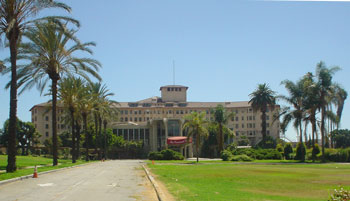
Here’s a view you can’t really see anymore. They’re tearing down most of the Ambassador Hotel in LA. The school district plans to build a new 4000-student high school which will integrate some parts of the old hotel, but not all. The famed Coconut Grove nightclub will be restored and will serve as the school’s auditorium, while the old coffee shop will be a teacher’s lounge, but most of the structure will be removed and replaced with new construction designed to “suggest” the appearance of the former occupant…
There was something of an uproar over the demolition of the Ambassador. Architecture aside, it was also the site of Robert Kennedy’s assassination in 1968. It’s no secret that yer humble host is a fan of old buildings, but in reality, what could they have done with this one? A big hotel building of this sort isn’t useful as much other than a big hotel building, and if a hotel were really essential at this spot, the Ambassador would probably still be one…
I love this building and I’m really sorry to see it go, much like I was sad to see Carolina Circle Mall in Greensboro go. But there’s almost no realistic way to adapt massive structures like these once they’ve outlived their original puropse. And even if there were a way (usually involving an astronomical public subsidy), the buildings would have to be so significantly altered that there would be little if any historical context left anyway…
I have a similar problem with the “restoration” of Charlotte’s Carolina Theatre. The auditorium has been gutted, the lobby and all surrounding structures have been demolished, and frankly, I question whether there’s enough left there to make it worth the investment to “save”, particularly when that investment is financed through tax dollars…
It’s much more prudent to talk about “adaptive reuse” when it involves buildings that can actually BE adapted for some useful and in-demand purpose. That’s one of the reasons I’m a big fan of Jane Jacobs stern rebuke of the “make no small plans” method of urban planning, which led to so many urban renewal suberblock monstrosities, most of which will also be impossible to adapt or re-use in the coming years…
Again, adaptive reuse is a great thing in appropriate circumstances and when there’s a demand and realistic use for the sapce. Spending a fortune in public money to build something inapproriate from scratch inside the carcass of a big old building reminds me of stuffing and freeze-drying a dead pet and plopping him down by the fireplace. It’s just a little bit creepy…